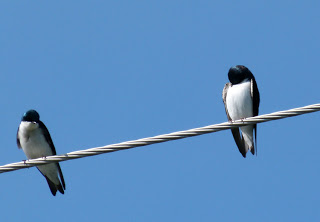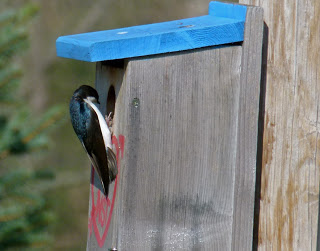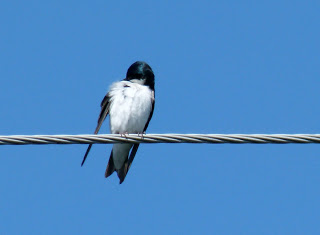The Tree Swallows are back in Kentucky, and this pair likes to sun and preen on the power lines just outside the Nature Center at Creasey Mahan Nature Preserve. Adults have dark blue iridescent feathers on their back, with a snow white throat and breast. Males and females look alike, although females may be a little more greenish. Some adults are drab gray. They look like they are wearing a tuxedo! Their long wingtips reach the tip of their tail; they do not have a long, scissor/forked tail like Barn swallows. Two more Swallows approached the line, and the male chased the other one away, so perhaps they will look for another nesting spot.
Like bluebirds, Tree Swallows are secondary cavity nesters, meaning they depend on pre-existing nest sites like nestboxes. Although they’re very social, they’re also territorial with their own species. Later in the nesting season, they defend a smaller area. They have been seen removing eggs from a chickadee nest. However, they can also be quite territorial, and may not like it when humans approach the nestbox, and may swoop, dive bomb, click their beaks and make a racket, especially if eggs are in the process of hatching. It’s best to leave them alone then! Tree Swallows spend a lot of time checking out and peering into a box. It seems like they put one piece of grass a day into the box! The nest is made of grass or pine needles and can be sort of sloppy. The cup, which is flatter than that of a bluebird, is lined with feathers most of which are added after egg laying begins. Downy feathers are often used in the cup, encircled by larger feathers that curl up over the eggs for insulation. Occasionally trash or bits of white birch bark, paper, tissue or cloth are used. Once the nest is feathered, it is rarely abandoned. Our Bluebird boxes at the Nature Preserve are used by Bluebirds, Tree Swallows, Chickadees, Wrens and House Sparrows.
They eat flying insects like beetles, horseflies, dragonflies, ants, moths, and mayflies. Because they rely on bugs, extended periods of cold rainy weather can be deadly. Adult Tree Swallows consume 2000 insects and feed 6000 insects to their young over a 45 day nesting period. That means that each nestbox family consumes more than 300,000 insects. Since 90% of their hunting takes place below 39 feet, they are making a real dent in human pestering insect populations.
I think Twitter must have gotten their name listening to Tree Swallows. This bird was more interested in cleaning his wings, but listen closely and you will hear him twitter to his mate. When you come to the Nature Preserve, watch these beautiful birds and listen for yourself!





